
The Frankston line is a commuter railway line in the city of Melbourne, Victoria, Australia. Operated by Metro Trains Melbourne, it is the city's third-longest metropolitan railway line, at 42.7 kilometres (26.5 mi). The line runs from Flinders Street station in central Melbourne to Frankston station in the south-east, serving 28 stations via South Yarra, Caulfield, Moorabbin, and Mordialloc. The line continues to Stony Point on the non-electrified Stony Point line. The line operates for approximately 20 hours a day with 24 hour service available on Friday and Saturday nights. During peak hour, headways of up to 5 to 10 minutes are operated with services every 10–20 minutes during off-peak hours. Trains on the Frankston line run with a two three-car formations of Comeng, Siemens Nexas, and X'Trapolis 100 trainsets.

The Flemington Racecourse line is a commuter railway line in the city of Melbourne, Victoria, Australia. Operated by Metro Trains Melbourne, it is the city's shortest metropolitan railway line at 7.8 kilometres (4.8 mi). The line runs from Flinders Street station in central Melbourne to Flemington Racecourse station, situated next to the racecourse in the city's north west, serving a total of 5 stations. The line operates only during special events, with services as frequent as every 4 minutes during peak periods of those special events. Trains on the Flemington Racecourse line run with two three-car formations of Comeng, Siemens Nexas, or X'Trapolis 100 trainsets.

Connex Melbourne was a train operator in Melbourne, Australia. Formed in July 1998 as Hillside Trains, a business unit of the Public Transport Corporation, it was privatised in August 1999 becoming a subsidiary of Connex.

The British Rail Class 423, electric multiple unit passenger trains were mostly built by British Rail (BR) at York Works from 1967 to 1974, although the MBSOs and TSOs of the first 20, 7701-7720, were built at Derby Works. They have manually opening doors next to every seating row and were the last coaching stock built in this pattern for BR. They were mostly found working outer-suburban services in South London and rural services in Kent, Sussex and Hampshire, up to 2005 when they were finally replaced by Electrostar and Desiro units. The fleet had a working life of 38 years.

The British Rail Class 456 was an electric multiple unit passenger train introduced by Network SouthEast on inner-suburban services in South London to replace the elderly Class 416 2EPB units. Twenty-four two-car units were built by British Rail Engineering Limited's York Carriage Works in 1990 and 1991.

The Hitachi was an electric multiple unit that operated on the Melbourne suburban railway network between 1972 and 2014. Electrical equipment was supplied by Commonwealth Engineering to designs by Hitachi of Japan, leading to their official name today, though no actual Hitachi-supplied components were used in their construction. They were the last suburban trains in Melbourne with no air conditioning. A total of 355 carriages were built between 1972 and 1981, including a replacement carriage for one written off while the fleet was still being delivered.

The British Rail Class 450 Desiro are third-rail DC electric multiple unit (EMU) passenger trains that entered service during 2003. Used for outer-suburban services, they were built with both first- and standard-class accommodation. They have a maximum speed of 100 mph (160 km/h).
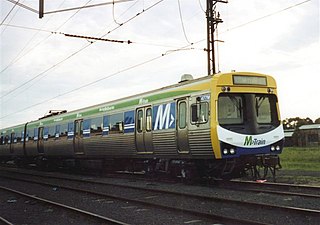
M>Train was a train operator in Melbourne, Australia, and operated some of the city's suburban rail operations. Formed in July 1998 as Bayside Trains, a business unit of the Public Transport Corporation, it was privatised in August 1999 becoming a subsidiary of National Express.
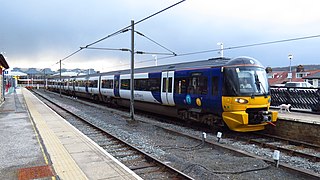
The British Rail Class 333 is a class of electric multiple unit (EMU) passenger train built by CAF between 2000 and 2003 for Northern Spirit, with traction equipment supplied by Siemens Transportation Systems. All have passed to subsequent franchises and subsequent operators Northern Rail, Arriva Rail North and Northern Trains.

The Harris trains were the first steel-bodied electric multiple unit (EMU) trains to operate on the suburban railway network of Melbourne, Victoria, Australia. They were introduced in 1956, by the Victorian Railways, and last operated in 1988, although a number of the carriages were converted for other uses and are still operating. They were named after Norman Charles Harris, Chairman of Commissioners of the Victorian Railways, between 1940 and 1950.

The British Rail Class 465 Networker is a class of 147 electric multiple units built by Metro-Cammell, British Rail Engineering Limited (BREL) and ABB Rail between 1991 and 1994. Originally operated by Network South East, these units are now run by Southeastern.
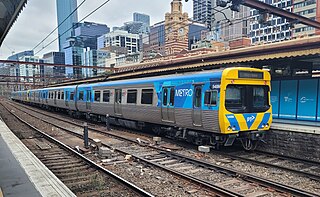
The Comeng is a class of electric multiple unit (EMU) operating on the suburban railway network of Melbourne. Built by their namesake Commonwealth Engineering, the trains were introduced in 1981 as a replacement for the Tait and Harris trains. In total, 190 three-car trainsets were built.
The X'Trapolis 100 is a class of single deck electric multiple units part of Alstom's X'Trapolis family of trains, operated in Melbourne, Victoria, Australia and Valparaíso, Chile.
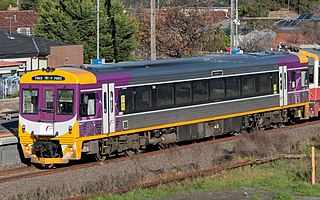
The Sprinter is a diesel railcar built by A Goninan & Co in Broadmeadow, NSW for V/Line between 1993 and 1995.
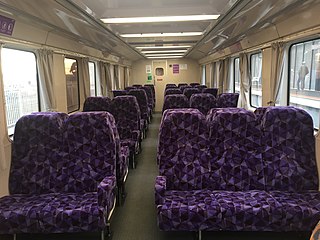
The H type carriages are a class of interurban passenger carriage operated by V/Line in Victoria, Australia. Fitted with high-density 2+3 seating, they were typically used on short distance interurban services from Melbourne to Bacchus Marsh and Geelong until their withdrawal in 2024.

The N type carriages are an intercity passenger carriage used on the railways of Victoria, Australia. They were introduced between 1981 and 1984 as part of the 'New Deal' reforms of country passenger rail services. Today they are seen on both V/Line long distance InterCity services, and limited commuter services to Geelong.
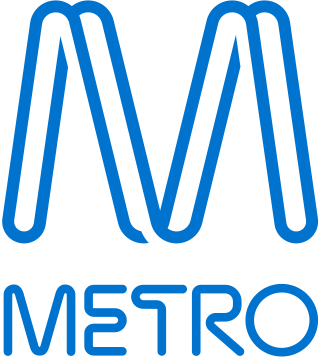
Metro Trains Melbourne, often known simply as Metro, is the operator and brand name of train services on the electrified metropolitan rail network serving the city of Melbourne, Victoria, Australia. It is the largest urban rail network in Australia, with 17 lines and 221 stations across 405 km (252 mi) of railways, and the second busiest network in Australia, with a patronage of 99.5 million as of 2021–2022.

The Tyne and Wear Metrocars are a fleet of light rail vehicles manufactured by Metro-Cammell for the Tyne and Wear Metro in North East England between 1978 and 1981. For operation on Network Rail controlled tracks between Pelaw Junction and Sunderland, they are designated on TOPS as the Class 599. Most were refurbished between 2010 and 2015 by Wabtec Rail at Doncaster Works and are scheduled to be replaced by Class 555 rolling stock from 2024.

The High Capacity Metro Train (HCMT) is a type of electric multiple unit (EMU) train for use by Metro Trains Melbourne on the Melbourne rail network. The first train set entered service on 27 December 2020 and will become the primary rolling stock used in the Metro Tunnel when it opens in 2025.

The X'Trapolis 2.0 is a series of electric multiple unit (EMU) trains to be used for Metro Trains Melbourne, part of Alstom's X'Trapolis family. The trains are set to enter service between 2024 and 2026.























